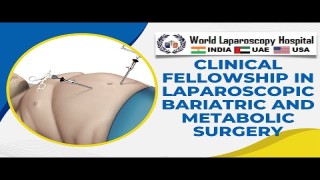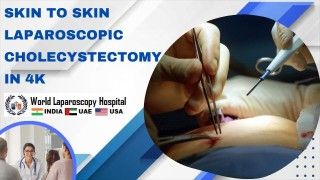Laparoscopic Surgery for Symptomatic Retroverted Uterus: Restoring Comfort and Function
Add to
Share
1,241 views
Report
1 year ago
Description
Introduction: A retroverted uterus refers to a condition where the uterus is tilted backward instead of the typical forward position. While many women with a retroverted uterus experience no symptoms or complications, some may develop symptoms such as pelvic pain, discomfort during intercourse, or difficulty with bladder or bowel function. In cases where symptoms are persistent and significantly affect a woman's quality of life, laparoscopic surgery can be an effective treatment option. This comprehensive article explores the details of laparoscopic surgery for symptomatic retroverted uterus, its benefits, and its role in restoring comfort and function. Understanding Symptomatic Retroverted Uterus: A retroverted uterus is a common anatomical variation and is generally considered a normal variant. However, when it causes symptoms that impact daily life, it is referred to as symptomatic retroverted uterus. Symptoms may vary among individuals but commonly include pelvic pain or discomfort, especially during menstruation or sexual intercourse. Bladder and bowel dysfunction, such as frequent urination or difficulty emptying the bladder, may also be experienced. In some cases, the retroverted uterus may contribute to infertility or difficulties during pregnancy. Laparoscopic Surgical Approach: Laparoscopic surgery offers a minimally invasive approach for managing symptomatic retroverted uterus. The procedure is typically performed under general anesthesia and involves making a few small incisions in the abdomen. Through these incisions, specialized instruments and a laparoscope—a thin, illuminated camera—are inserted. The laparoscope provides a magnified view of the pelvic organs, allowing the surgeon to precisely manipulate and reposition the uterus. During the surgery, the surgeon carefully releases adhesions or ligaments that may be contributing to the retroversion. The uterus is then repositioned into the desired forward position and fixed in place using sutures or specialized devices. Additional procedures, such as repairing associated pelvic organ prolapse or removing adhesions, can be performed simultaneously if necessary. Benefits of Laparoscopic Surgery for Symptomatic Retroverted Uterus: Minimally invasive approach: Laparoscopic surgery involves smaller incisions, resulting in reduced postoperative pain, faster recovery times, and improved cosmetic outcomes compared to traditional open surgery. The minimally invasive nature of the procedure also reduces the risk of complications, such as infection or excessive bleeding. Precise repositioning: The laparoscopic technique allows for precise manipulation and repositioning of the retroverted uterus. This ensures optimal placement and fixation of the uterus, addressing the underlying cause of symptoms and providing long-lasting relief. Simultaneous treatment of associated conditions: Laparoscopic surgery for symptomatic retroverted uterus offers the advantage of addressing other associated conditions during the same procedure. This may include repairing pelvic organ prolapse, removing adhesions, or treating other gynecological concerns, if present. Restoring Comfort and Function: Laparoscopic surgery for symptomatic retroverted uterus aims to restore comfort and function for women experiencing related symptoms. By repositioning the uterus into its normal forward position, the surgery helps alleviate pelvic pain, discomfort during intercourse, and bladder or bowel dysfunction. It can also improve fertility outcomes in cases where retroversion contributes to infertility. The surgery provides a long-term solution, allowing women to resume their daily activities without the limitations imposed by symptoms. Postoperative Care and Recovery: Following laparoscopic surgery for symptomatic retroverted uterus, patients may experience mild discomfort or bloating, which can be managed with pain medication as prescribed by the surgeon. It is important to follow postoperative care instructions, which may include taking prescribed medications, wearing a support garment, and avoiding strenuous activities for a specified period. Patients should attend follow-up appointments to monitor their recovery progress and address any concerns or questions they may have. While complications are rare, it is essential for patients to be aware of potential risks associated with laparoscopic surgery for symptomatic retroverted uterus. These risks may include infection, bleeding, damage to surrounding organs, or recurrence of symptoms. Patients should promptly report any unusual symptoms or signs of complications to their healthcare provider. Conclusion: Laparoscopic surgery for symptomatic retroverted uterus offers a minimally invasive and effective approach to restore comfort and function for women experiencing related symptoms. By repositioning the uterus into its normal forward position, this procedure alleviates pelvic pain, discomfort during intercourse, and bladder or bowel dysfunction. It also addresses associated conditions, such as pelvic organ prolapse, simultaneously if needed. With its benefits of smaller incisions, faster recovery times, and precise repositioning, laparoscopic surgery provides long-term relief and improves the quality of life for women with symptomatic retroverted uterus. Individualized evaluation by a skilled surgeon is crucial in determining the suitability of laparoscopic surgery for each patient. Consulting with a gynecologist experienced in laparoscopic techniques ensures optimal outcomes and patient satisfaction. Through careful planning, meticulous surgical technique, and comprehensive postoperative care, laparoscopic surgery for symptomatic retroverted uterus offers a promising solution for women seeking relief from related symptoms, ultimately restoring their comfort and function.
Similar Videos






